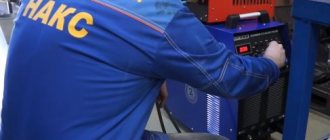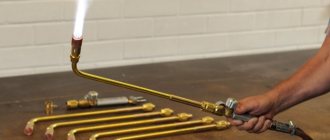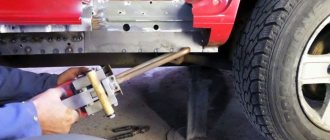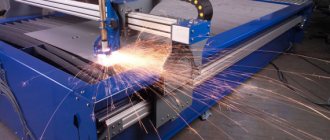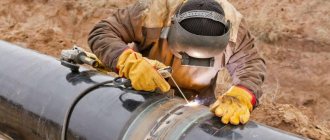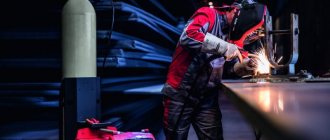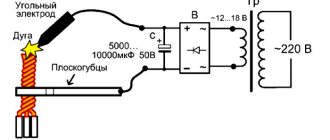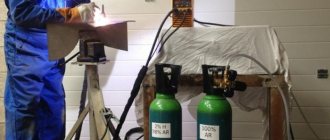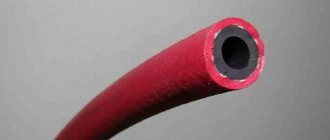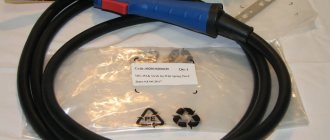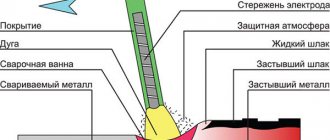Features of gas welding
During the work process, it is possible to regulate the composition of the mixture, which the gearbox helps with. The flame power and temperature are adjusted depending on the type of work. There are several types of gas welding:
- Oxidative.
- Restorative, which is used for most compounds and materials.
- With an increased level of combustible mixture.
In the molten pool during welding processes, two main processes occur, reduction and oxidation. The structure of the adjacent metal is mainly coarse-grained, for a more durable connection.
For improved strength indicators, heating is performed to maximum temperatures, a kind of forging of the metal.
Several main features when working with gas equipment:
- Gas welding of low-carbon steel materials is carried out using various types of gas, the filler element consists of steel wire, with a small amount of carbon content.
- Alloy steels are welded with materials that react with the composition. For example, heat-resistant stainless steel parts are welded using nickel wire; some grades of material will require the use of molybdenum.
- Copper products are welded at elevated temperatures; the high fluidity of the metal will require minimal joint clearance. The filler material consists of copper wire and flux, which is used to deoxidize the weld.
- Brass connections are made by using an additive of identical material. Due to the volatility of zinc, more oxygen is supplied during welding to avoid the formation of pores.
- Bronze alloys are welded using a reduction flame without burning out the main components of the metal. For the additive, an identical material is used using silicon, which promotes deoxidation of the weld and metal.
Gas pipe welding
It is worth noting that when working with aluminum or magnesium, oxidation processes proceed faster. The processing area and the seam have different parameters and characteristics; the adjacent area located in close proximity is characterized by reduced strength and is prone to premature deformation.
Types of flame and gases used in this welding method
The heating temperature and the ability to work with different metals depend on the flame during gas processing. There are three zones in the flame: the core where acetylene decomposes, the reduction zone in which carbon and hydrogen are oxidized, and the torch or area of complete combustion of gases.
There are three types of flame, each depending on the ratio of acetylene to oxygen.
“Normal” is a reducing flame in which the rates of oxidation and reduction of the metal are the same. Most often, this type of flame is used in the process of work. For processing bronze and other alloys containing tin, only reducing fire is suitable.
To obtain an oxidizing flame, the oxygen content in the gas mixture is increased. This is the flame that is used in the brass joining and brazing process. The fact is that the oxidizing flame allows you to increase the speed of gas processing.
However, everything is not so simple - to get a good result you will have to use a special additive that contains deoxidizing agents, that is, manganese and silicon. If you use a material similar to the material of the workpieces as a filler wire, the weld will be brittle, with many pores and cavities. But note that this rule does not apply to brass wire.
A flame with a higher proportion of flammable gas is suitable for surfacing one part with another, made of a harder alloy. In addition, the technology of gas welding of aluminum and cast iron is based on its use.
Typically, flame treatment is carried out using a specific gas, acetylene (C2H2). It has a rather pungent odor and is produced industrially by reacting calcium carbide with water. This gas burns at +335 °C and above, but when combined with oxygen, the ignition temperature drops to +297 °C.
For the gas press method, oxygen mixed in equal parts with C2H2 is most often used. Enterprises supply O2 in blue cylinders. Before starting work, oxygen is connected to the burner using a hose and supplied at low pressure, no more than 4 atm. C2H2 is connected to the adjacent hole. The burner has a device that allows you to mix gases, so the finished concentrate comes out through the tip.
When processing metals whose melting point is lower than that of steel, substitute gases such as propane, methane, and hydrogen are often used.
Propane is a technical colorless gas with a pungent odor, heavier than air. When working with metals, a mixture of propane and butane is used, in which the share of butane is in the range of 5–30%. Note that the temperature of the propane-oxygen flame reaches +2400 °C.
The mixture of methane and oxygen is practically odorless, and the flame temperature is +2100...+2200 °C. For this reason, they try to use this composition not so often.
Hydrogen is a light, odorless and colorless flammable gas. When combined with oxygen and air in certain proportions, it can form an explosive mixture, so it is very important to remember safety precautions when working with it. Hydrogen is supplied to enterprises in a gaseous state in green steel cylinders. The hydrogen-oxygen flame has a blue tint and has unclear zone contours, which greatly complicates its adjustment.
For the gas-flame method of processing steel products with methane or propane, wire with a high content of manganese and silicon is used.
Operating principle of gas welding
Oxygen and flammable gas are supplied to the device through pipes, ignition occurs through the nozzle, and the flame power is adjusted by valves. The flame consists of several main parts, the torch, the recovery process and the core. The highest temperature parameters are observed in the core; the process occurs as part of the flame between the core and reduction.
The impact of high temperatures on the surfaces of materials entails protection of the welding area from excess air, which contains impurities of heavy gases. High performance when cutting metals allows you to perform work with high precision and produce the necessary products. There are different types of gas welding.
Welding equipment
Welding gas plays a big role in the density and quality of the joint; the popular gas used is acetylene.
Formation of a welded joint
When heated by a burner flame, local melting of the metal of the connected parts occurs. The molten metal of the edges together with the metal of the additive forms a weld pool. Its boundaries are defined by solid metal. Liquid metal wets the edges of parts, removes the film covering them, and creates the possibility of the manifestation of interatomic interaction forces.
During the welding process, the gas flame moves along the edges of the parts being joined, and the weld pool moves with it. As a result of sequential cooling and solidification of the weld pool metal, a welded joint is formed.
The volume of the weld pool is small compared to the volume of the parts being joined, so intense heat removal occurs. To maintain the metal of the weld pool in a liquid state and the normal course of the welding process, it is necessary that the heating source have a high temperature and have high thermal power. In oxy-acetylene welding, only 10% of the total thermal power of the flame is spent on useful heating of the metal, the rest is spent on compensating for various heat losses.
Gas welding technology
Gas welding technology uses an additive made of light alloy material, the main task of which is to fill the edges of materials. An acetylene torch is used to melt the edges by heating, after which the joint is made. The second method involves surfacing or spraying, depending on the type of metal and equipment. The difference between the methods is in the consumption of the gas mixture, the materials being processed, and the time spent on the operation.
Pollination of two metal compounds will require high temperatures, this will require an increased amount of combustible mixture. Heating the filler rods does not require high temperatures; the structure of the tool consists of low-melting materials. There is a special type of electrodes for connecting materials with inverter type equipment.
The gas welding technique using various additives is much stronger, more pleasant in appearance, the process is faster, and the consumption of the combustible mixture is several times lower.
Welding wire
This technology of welding work is used in various fields, connecting technological pipelines, spare parts of machines, welding rods, forging various fragments.
The gas welding process will require the following basic elements:
- In most cases, propane is used as gas. Various types of gas with inert fluidity are suitable.
- The catalyst for ignition is a cylinder of oxygen gas.
- Hoses for removing the gas mixture, nozzle, reducer on the cylinder and handle.
The calibration nozzle sprays the gas mixture under pressure, a silicon piezo lighter is used to ignite, after which the saturation of the mixture and the strength of the flame are adjusted.
The essence of the process
The essence of the gas welding method is that a hot gas stream is supplied through a special nozzle to the working surfaces. It heats the edges of parts to critical temperatures, melts the filler material, which is fixed to the nozzle or supplied to the heating site from the other side.
Gas displaces air from the heating site. Therefore, no oxide film is formed. Gradually the metal cools, the parts come together. Before carrying out work, you need to learn how to choose gases for welding:
- The most popular mixture is oxygen with acetylene.
- Propane with oxygen.
- Hydrogen with oxygen.
- Methane with oxygen.
To weld metal parts, you can use any flammable gas with the addition of oxygen. However, the best option is acetylene. This is due to the operating temperature that this gas can provide - up to 3400 degrees Celsius. For propane, this figure reaches 2800 degrees.
Pros and cons of gas welding
Each type of work performed implies the presence of certain advantages and disadvantages. A welding connection is possible using various equipment and tools and depends on the properties of the material. The advantages and disadvantages of gas welding are determined by several points.
Main advantages:
- One of the most important advantages of gas welding is the availability of equipment and the lack of energy requirements. Welding work can be performed with two cylinders and a cutter. An excellent solution for remote locations without electricity.
- The connection of thin sheet metals is carried out very carefully, with high quality due to the possible adjustment of the flame distance and temperature conditions.
- Transportation does not require large expenses; there is no need to purchase special equipment for moving and storing.
- A reliable seam and high-quality work allow you not to worry about the durability of welding joints.
Weld
Disadvantages of gas welding:
- Welding products with high precision requires a highly qualified operator; products are produced slowly.
- Large circumferential range, high temperature.
- Increased consumption of components, welding gas and wires is required.
Oxidative type of welding flame
An oxidizing welding flame is produced when there is an excess of oxygen. Those. when the ratio of oxygen to acetylene is greater than 1.3. The core of an oxidizing flame is shorter than that of a reducing flame. It has a sharper outline and is less bright. The reduction zone and flame are also shorter in length than a normal flame.
The temperature of the oxidizing flame is slightly higher than that of the normal flame. This type of flame is not suitable for welding steels, because... Excess oxygen promotes oxidation of the metal, resulting in the formation of multiple defects in the weld in the form of pores. The seam itself is fragile. An oxidizing flame is often used when welding brass.
Materials for welding using gas
The technological process using gas materials depends on a number of reasons and factors. The main and unchangeable gas is oxygen in its technologically pure form. The purpose is to activate the combustion processes of metal parts for connection at a later time. The gas is transported and kept under high pressure for long-term operation outside the gas station. Storage and contact with technical oils is unacceptable, and it is also not recommended to use oxygen in direct sunlight.
Pure oxygen is obtained from ordinary air; special devices are used for purification. Oxygen is divided into categories: highest, first and second grade. Working with materials is impossible without the accompanying oxygen gas. In most cases, colorless acetylene is used. Acetylene is produced by combining water with calcium carbide and is explosive at certain temperatures.
Acetylene for welding
The use of acetylene is determined by high temperatures when welding joints; cheaper analogues do not make it possible to produce high-quality work due to insufficient combustion temperature.
Wire and flux for welding
The wire is used for gas welding and is necessary to replenish the cells of released compounds. The use of flux and wire makes it possible to create a correctly formed seam with the necessary characteristics. Cleanliness and absence of signs of corrosion on the wire material makes it possible to produce a high-quality product; in some cases it is possible to use a piece of the same material that is being welded. Flux provides protection from oxides and other influences surrounding the installed metal.
Welding flux
Neglecting the use of flux for welding is possible only when producing materials from carbon steel. Boric acid, used as a flux, is applied to parts made of copper, magnesium or aluminum.
Gas welding equipment
In addition to the gases and cylinders used, it is necessary to have other technological elements:
- For gas welding, equipment is used, such as a water-type shutter, which provides protection against the backdraft of fire. The location occurs between a container with acetylene and a gas nozzle.
- Reducers are used to control the gas level at the outlet of the cylinder. There are various models, reverse or direct acting. Modifications for working with liquefied gas imply the presence of scars inside the structure, which eliminates freezing.
- A special type of hose is used to supply gas to the burner. Marking occurs in different colors depending on the maximum pressure.
- The burner is necessary to mix the combustible mixture and subsequently ignite the gases. Various modifications are divided into injection and conventional types. The division also occurs according to the power required during operation.
- Gas welding is performed on a equipped table. Equipped with a tabletop for convenient, productive work. The gas welding and cutting machine must comply with safety parameters. Exhaust ventilation helps the welder and allows processes to be carried out at maximum speed.
Gas-burner
Gas welding equipment includes a huge range of instruments and mechanisms. Taken together, the equipment allows work to be carried out at a location remote from energy sources. Each type of equipment is equipped for the type of gas used, with proper adherence to safety precautions.
Advantages and disadvantages
Any technological process for joining metals has a number of strengths and weaknesses. A special feature of welding is that the welding gas slowly heats the working area. This cannot be called a clear plus or minus.
Advantages:
- Smooth, uniform heating, which is needed for melting non-ferrous metals.
- No powerful source of electricity is needed.
- Ability to control the power of the hot jet.
- Availability of additional controllers for switching operating modes.
Flaws:
- Low efficiency due to large heat dissipation when heating metal with gas.
- Large heating zone. It is impossible to carry out precise work.
- The gas consumed is more expensive than the electricity consumed to carry out the same work.
- Cylinders, cutters, connecting hoses are not convenient to transport.
- It takes practice several times to learn how to make quality seams.
Most cutters are manual equipment that cannot be automated. Difficulties in automating the process can be considered a disadvantage.
How gas welding is performed in semi-automatic mode
Semi-automatic gas welding involves a hybrid method of joining metals. Applied using shielding gas and an electric arc, the process proceeds as follows:
- Starting mechanisms, preparing tools for work.
- A wire is threaded into a special hole in close proximity to the burner.
- The gearbox controls and sets the level of the combustible mixture.
- The wire feed speed is controlled by a special mechanism on the drum.
- The voltage and other parameters are set semi-automatically.
- Before starting the process, it is necessary to set the burner at the correct angle.
For a high-quality connection and uniform formation of a seam, when using this type of welding, parameters have been developed in accordance with GOST.
The pressure of the reducer must be at certain values, the type and parameters of the hoses. Cylinders containing gas must be pressurized and tested; burners and wire differ in parameters and must comply with established procedures. The check must be carried out before welding metals.
Standards
GOST for gas welding is a special issue. Due to the fact that the quality of a weld in gas welding largely depends on the skill of the welder, it is determined subjectively.
The nature of the gas welding process is exclusively manual; there is no specific GOST for gas welding . But there is GOST 1460-2013 - for calcium carbide, from which gas for welding is produced.
In addition, various GOSTs define parameters such as types of filler wire, pressure in the gearbox and cylinder, and requirements for the acetylene generator. There are specific requirements for the types of hoses and burners used, related to operational safety.
Precautions and rules for using a gas burner
The welding process can harm both the worker and others if basic safety rules are not followed. It is prohibited to carry out gas welding work in a confined space, or it must be equipped with good ventilation. Safety glasses prevent the influence of rays on the retina of the eyes, as well as metal splashes.
The welding station must be kept clean, the cylinders must be well secured in place and tested by pressure testing. Gas cylinders are transported on a specialized stretcher or trolley. During transportation, the operator must install a protective device on the top of the container. The work is carried out with a flame emanating in the other direction from the cylinders. If space is limited, a protective metal shield is installed and the temperature is controlled.
Safety precautions
Before you start working, it is important to study the safety rules and adhere to them:
- Do not use the equipment near flammable substances or liquids.
- Work only in a well-ventilated area. If the building is not ventilated, take breaks during work so that the welder can get some fresh air. It is advisable to use a respirator.
- It is important to check that the equipment elements are not stained with oil.
- To cool the nozzle, there should be a container with cold water nearby.
- Prepare the work area before welding begins. Interference during operation can lead to injuries and defective workpieces.
- Use safety glasses, a special welding suit, and gloves.
Before starting work, check how securely the connecting hoses are connected. There should be no gas leak.
Gas welding is a popular method of thermal joining of metal parts. Before starting welding work, you need to familiarize yourself with the features of the technological process, prepare the equipment and parts to be welded. In order not to harm the body, it is important to follow safety rules.
